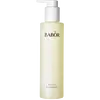What's inside
What's inside
 Key Ingredients
Key Ingredients

 Benefits
Benefits

 Concerns
Concerns

 Ingredients Side-by-side
Ingredients Side-by-side

Caprylic/Capric Triglyceride
MaskingCetyl Ethylhexanoate
EmollientIsononyl Isononanoate
EmollientPEG-7 Glyceryl Cocoate
EmulsifyingIsopropyl Myristate
EmollientSimmondsia Chinensis Seed Oil
EmollientGlycine Soja Oil
EmollientSesamum Indicum Seed Oil
EmollientRibes Nigrum Seed Oil
EmollientTocopheryl Acetate
AntioxidantPEG-20 Glyceryl Triisostearate
EmollientPolysorbate 20
EmulsifyingParfum
MaskingButyrospermum Parkii Butter
Skin ConditioningCarapa Guaianensis Seed Oil
Skin ConditioningVaccinium Macrocarpon Seed Oil
Skin ConditioningCaprylic/Capric Triglyceride, Cetyl Ethylhexanoate, Isononyl Isononanoate, PEG-7 Glyceryl Cocoate, Isopropyl Myristate, Simmondsia Chinensis Seed Oil, Glycine Soja Oil, Sesamum Indicum Seed Oil, Ribes Nigrum Seed Oil, Tocopheryl Acetate, PEG-20 Glyceryl Triisostearate, Polysorbate 20, Parfum, Butyrospermum Parkii Butter, Carapa Guaianensis Seed Oil, Vaccinium Macrocarpon Seed Oil
Glycine Soja Oil
EmollientSesamum Indicum Seed Oil
EmollientArachis Hypogaea Oil
Skin ConditioningDecyl Oleate
EmollientOctyldodecanol
EmollientPEG-40 Sorbitan Peroleate
EmulsifyingAlcohol Denat.
AntimicrobialHelianthus Annuus Seed Oil
EmollientParfum
MaskingTocopheryl Acetate
AntioxidantTocopherol
AntioxidantWater
Skin ConditioningBisabolol
MaskingGeraniol
PerfumingBenzyl Alcohol
PerfumingQuillaja Saponaria Bark Extract
Cleansing
 Reviews
Reviews

Ingredients Explained
These ingredients are found in both products.
Ingredients higher up in an ingredient list are typically present in a larger amount.
Glycine Soja Oil comes from the soybean. Glycine Soja is native to eastern Asia.
Soybean oil is an emollient. It is rich in antioxidants and fatty acids including palmitic, stearic, oleic, and linoleic acids.
As an emollient, the fatty acids in soybean oil helps keep your skin soft and hydrated. It does so by creating a film on top that traps moisture in.
Soybean oil is also rich in vitamin E, a potent antioxidant. Vitamin E is also anti-inflammatory and provides a soothing effect.
Studies show soy may help fade hyperpigmentation from UVB. It does so by disrupting the melanin process from UVB induced skin inflammation.
This ingredient may not be malassezia folliculitis, or fungal-acne, safe.
Soybeans are rich in proteins and are part of the legume family. Foods made with soybeans include tofu, soymilk, edamame, miso, and soy sauce.
Learn more about Glycine Soja OilParfum is a catch-all term for an ingredient or more that is used to give a scent to products.
Also called "fragrance", this ingredient can be a blend of hundreds of chemicals or plant oils. This means every product with "fragrance" or "parfum" in the ingredients list is a different mixture.
For instance, Habanolide is a proprietary trade name for a specific aroma chemical. When used as a fragrance ingredient in cosmetics, most aroma chemicals fall under the broad labeling category of “FRAGRANCE” or “PARFUM” according to EU and US regulations.
The term 'parfum' or 'fragrance' is not regulated in many countries. In many cases, it is up to the brand to define this term.
For instance, many brands choose to label themselves as "fragrance-free" because they are not using synthetic fragrances. However, their products may still contain ingredients such as essential oils that are considered a fragrance by INCI standards.
One example is Calendula flower extract. Calendula is an essential oil that still imparts a scent or 'fragrance'.
Depending on the blend, the ingredients in the mixture can cause allergies and sensitivities on the skin. Some ingredients that are known EU allergens include linalool and citronellol.
Parfum can also be used to mask or cover an unpleasant scent.
The bottom line is: not all fragrances/parfum/ingredients are created equally. If you are worried about fragrances, we recommend taking a closer look at an ingredient. And of course, we always recommend speaking with a professional.
Learn more about ParfumSesame oil comes from sesame seeds. Sesame oil is rich in fatty acids and Vitamin E.
It has antibacterial, antioxidant, and anti-inflammatory properties. The phenolic compounds of this ingredient (including vitamin E) give it these properties.
Unrefined sesame oil has a comedogenic rating of 3, while refined sesame oil has a rating of 1. This ingredient may not be fungal-acne safe.
The fatty acids in sesame oil include linoleic acid (41%), oleic acid (39%), palmitic acid (8%), stearic acid (5%), and some small traces of others.
Learn more about Sesamum Indicum Seed OilTocopheryl Acetate is AKA Vitamin E. It is an antioxidant and protects your skin from free radicals. Free radicals damage the skin by breaking down collagen.
One study found using Tocopheryl Acetate with Vitamin C decreased the number of sunburned cells.
Tocopheryl Acetate is commonly found in both skincare and dietary supplements.
Learn more about Tocopheryl Acetate